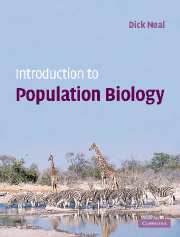Book contents
- Frontmatter
- Contents
- Preface
- Acknowledgements
- PART I Evolution by natural selection
- PART II Simple population growth models and their simulation
- Chapter 4 Density-independent growth and overproduction
- Chapter 5 Density-dependent growth, and the logistic growth model
- PART III Population genetics and evolution
- PART IV Demography
- PART V Interactions between species, and the behaviour of individuals
- Glossary
- Solutions to problems
- References
- Index
Chapter 5 - Density-dependent growth, and the logistic growth model
- Frontmatter
- Contents
- Preface
- Acknowledgements
- PART I Evolution by natural selection
- PART II Simple population growth models and their simulation
- Chapter 4 Density-independent growth and overproduction
- Chapter 5 Density-dependent growth, and the logistic growth model
- PART III Population genetics and evolution
- PART IV Demography
- PART V Interactions between species, and the behaviour of individuals
- Glossary
- Solutions to problems
- References
- Index
Summary
Organisms have a phenomenal potential for increase in numbers when there are no limits to growth. We may enjoy calculating this potential, but don't worry that if we leave the house for a few days we will return to find bacteria many metres deep over the kitchen counters, or if we lock up our summer cabin and inadvertently enclose a female housefly that we will return next spring to find trillions of her offspring buzzing about the place. We recognize that there are insufficient resources to sustain such growth because we live in a finite world, and although we see many instances of population increase we know that there are limits to the size they may eventually reach.
This chapter will focus on developing models which describe how population growth may be influenced by population density through the effects of intraspecific competition for resources. As populations increase in density, the resources needed to sustain them become limiting. For example, barnacles may cover the entire surface of a rock until there is no more space available for further growth of the population. Similarly, cavity nesting birds may have the size of the breeding population limited by the availability of suitable holes in trees. The basic premise of our models is that the realized growth rate will decline as population density increases.
Logistic growth model
The logistic growth model modifies the exponential growth equation δN∕δt = rmN by making the growth rate per capita, r, a function of density, f(N).
- Type
- Chapter
- Information
- Introduction to Population Biology , pp. 68 - 84Publisher: Cambridge University PressPrint publication year: 2003



